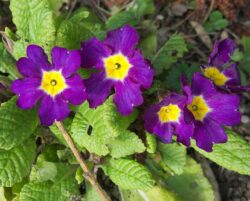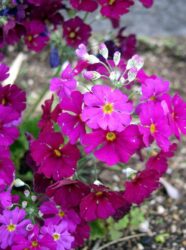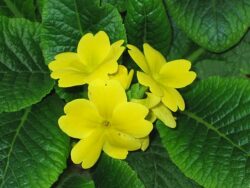In this article, we will be discussing how to grow the popular outdoor plant primulas indoor. At one time primulas were popular indoor plants, but not much so today. I wish now to revive this trend and tell you how to grow these beautiful colourful flowers indoors.

Often you will find primulas on sale in garden centres and shops in late winter and early spring, where they can bring cheer and colour to often a bleak time of year.
Garden primroses consist of several species that are often hybrids and cultivars that are derived from Primula vulgaris and Primula veris. These hybrids are often given the name Polyanthus (Primula x hybrid).
The beauty is that they have such vibrant colours of red, yellow, purple, pink, and white and often have distinct patterns.

What must be borne in mind is that most primrose you buy for indoors are meant for short term use for discarding after the show of bloom have finished. This and most are grown for outdoor use will give you a clue that the odds of growing successful indoors is against you.
It is possible to nurture them into repeat-flowering, but inside this is very difficult to do. It is best to see them as temporary visitors and not long term residence. If you are green-fingered and have time and patience, you can grow them from seeds, but it can take up to 3 years to reach maturity and flower.
HOW DO YOU CARE FROM PRIMROSE INDOOR?
As you can imagine, it is not easy to grow primrose indoors as is it is outdoors. They need the right combination of sunlight moisture and fertiliser to survive and flourish.

You can extend the periods of bloom by removing spent flowers but often it is a losing battle, as it will not rebloom again in the home. Much like bulbs grown in the home, you will have to plant out afterwards to prevent the plants from being thrown away.
COMPOST
Primroses prefer composts that are well-drained, nutrient-rich with a high level of organic matter. Most multipurpose compost will be suitable for this, where you can add a 50% mix of perlite to help drainage. There is nothing special about the growing media that is required.
LIGHT
Primroses grown indoors prefers a well-lit windowsill but out of direct sunlight. When planting outdoors after it has finished its show, it is best to place them in a dapple shade.
WATER
Primroses need the compost to be evenly moist to thrive; neither too soggy nor too dry. It is very important to not overwater as they do tend to suffer from root rot and/or other fungal infections. You must check the compost before you water as wilting can be a sign of root rot as well as under-watering.
TEMPERATURE
Primrose prefers it on the cool side, as intense heat can cause wilting and death of the plant. A temperature between 10 and 15 degree Celsius is ideal but it will suffer if the temperature is greater than 25 degree Celsius.
HUMIDITY
Primroses like the air to be humid and moist. This can be achieved by the use of a humidifier or by seating the plant over a tray filled with expanded clay balls, and a thin layer of water.
FERTILIZING
It is best to fertilize with a liquid houseplant fertilizer once the growing season arrives and the plant starts to flower. As they are not meant to be for long term use in the home, a simple application may be enough for the flowering season.
GROWING PRIMROSE FROM SEED
Primroses can be grown from seeds but this is not easy to do, as they are quite susceptible to dampening-off disease. If you plant primroses you are expected to lose some seedlings and it may not produce any viable plants.
If you enjoy a challenge and you want to grow more visually varieties then this is the way to go. It is only recommended if you have the room and are patient.

Use a seed compost and fill a seed tray to nearly the brim, making sure that the compost is given a good soak.
Flatten the surface and on top of this, sprinkle the seeds and then cover with a fine layer of vermiculite that has been milled to a fine powder. Cover it with a propagation lid and then place the tray in a cool area where it gets good light. Keep the compost moist by spraying it with water regularly.
It may take a while and the germination rates may be low, but you will get some seed that will sprout. As the seeds grow you will need to thin the seedlings to allow the rest to grow on. Once the true leaves emerge, you can transplant them individually to 7.5cm pots.

As they grow in individual pots, you will need to provide low temperature, bright lights and keep them moist at all times. The seedlings are so slow-growing and you will need to keep them for 3 years before they will bloom.
VARIETIES TO GROW
The following are my recommended varieties of primulas to grow indoors:
PRIMULA x KEWENSIS (Kew Primrose)
This is a primrose that has whorls of fragrant yellow flowers whose stems and buds coated with a whitish floury surface. Look out for ‘Sungold’ and ‘Yellow Perfection’. Best watered with rainwater.
PRIMULA MALACOIDES (Fairy Primrose)

This primrose has numerous stems bearing whorls of dainty flowers, borne one above the other, arising from a rosette of attractive leaves. The flower can come in many colours. This is a plant that must be grown from seeds. Do not place water on the leaves and base of the rosette as this will encourage root rot.
PRIMULA x POLYANTHA (Polyanthus)
These are the familiar plants that have large heads of flowers of many colours that are borne well above the foliage on stout stems and are often fragrant. Be aware as it can suffer from red spider mites that need to be dealt with as it can ruin plants. Spray with a suitable systemic pesticide.
PRIMULA SINENSIS (Chinese Primrose)
This is a large primrose that has large flowers on strong stems above the foliage. This can be said to have some of the brightest coloured flowers, such as ‘Dazzler’ that has vivid orange-scarlet flowers. Most need to be grown from seed. Careful as the plant will cause an allergic skin reaction if touched.
PRIMULA VULGARIS (Common Primrose)
This is the familiar primrose that is often seen in gardens up and down the country. It has flowers of many shades of colours so you do have a choice. Best grown from seed, but it can be propagated via divisions.
CONCLUSIONS
In this article, we have discussed the best way to grow your indoor primulas that are often seen as a temporary plant. Most will have to be grown from seed apart from the polyanthus and common primrose that are often sold in spring.
You can have wonderfully scented and colourful plants to grace your home, but if you want this you will need to put in the time and effort.
If you are planting from seeds you will need to be patient as it can take up to 3 years to enjoy the blooms. Some like the Chinese primrose will need to be discarded after flowering, whilst the others will need to be planted outside to continue to enjoy their beauty.
If you have any comments or questions that you wish to make on primulas, please do so in the comment box below.
Happy Primrose growing.
